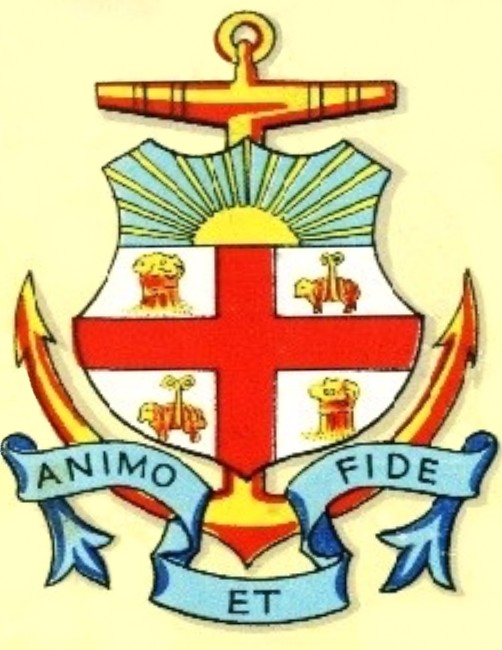

EAST LONDON / OOS-LONDEN / IMONTI
Province: Eastern Cape (previously Cape Province/Cape Colony).
District council: Amatola (previously East London Division)
Incorporated: into Buffalo City Local Municipality, 2000.
Additions: East London East, Panmure (1873), Cambridge (1942), Berlin (1970), Gompo, Mdantsane, Beacon Bay, Gonubie (1995).

These arms were granted by the College of Arms (the deed termed a grant by Letters Patent) on 13 December 1959:
Arms: Ermine a Cross Gules between in the first and fourth quarters a Garb and in the second and third quarters a Fleece Or on a Chief Azure a demi Sun Gold.
Crest: On a Wreath Argent and Gules Two Anchors in saltire the shanks enfiled by a Mural Coronet Or.
Supporters: On either side a Buffalo Sable.
Motto: Animo et Fide.
About the arms:
The notes that appear below the illustration of the arms as printed by Shaw and Sons, of London, read:
“These arms follow closely an earlier device adopted by the Town Council in August 1892. The shield depicts the cross of Saint George, with sheaves and trussed sheep denoting agriculture and commerce. Above the rising sun, signifying the East. Below, aloes indigenous to the Eastern and Border areas of the Cape Province.
“The Crest shows two crossed anchors, symbolic of the seaport, set through a mural (walled) crown.
“The supporters are two buffalo bulls, as reference to the Buffalo River on which the city stands.
“The motto: By Courage and Faith.”

The 1892 arms of East London showed the wheat sheaves (garbs) and fleeces (trussed sheep) in gold on a field argent (silver or white). Heraldry does not permit the placing of gold charges on silver, since there is insufficient contrast, so the field was changed in 1959 to ermine.
The 1892 arms did not include crest or supporters (in the British tradition), but showed a gold anchor behind the shield in a fashion reminiscent of the arms of Cape Town and the drostdijen of the Cape Colony as granted in 1804 by Commissioner-General Jacob Abraham Uitenhage de Mist. The heralds either did not know of the significance of the anchor in this position, or felt it inappropriate, so the anchor supporter became two anchors in the crest.
The supporters are Cape buffalo (Syncerus caffer), once common in the area but now only seen (reintroduced) on game farms and reserves.
In other respects the arms and the motto are unchanged, and only redrawn.
However, the herald painter used a shield outline of a style no longer regarded as proper, perhaps because the 1892 arms used a similar style.
About the city:
In 1804 the area where East London stands was far from the frontier of the colony, which lay at the Bushmans River, and when it came under British rule it became part of the short-lived Province of Queen Adelaide (in 1836) and subsequently of the colony of British Kaffraria in 1847, although it did not long remain part of this new colony.
East London was founded on the west (right) bank of the Buffalo River and grew up around Fort Glamorgan (first built in 1847). A proclamation by Governor Sir Harry Smith on 14 January 1848 annexed the river port and an area two miles around it to the Cape Colony.
By 1873 there were three villages around the river mouth: East London (today called West Bank), East London East (on the left bank, the present-day city centre) and Panmure (now the northern part of the city centre). The three were merged by a proclamation of 22 April 1873 which provided for municipal commissioners. The first commissioners were elected on 20 May in the same year.
A provincial ordinance of 1 June 1914 elevated East London to the status of a city.
The reorganisation of municipal government in 1995 saw not only the black towns of Gompo (formerly Duncan Village) and Mdantsane (a dormitory city erected in Ciskei) but also the independent municipalities of Beacon Bay (east of the Nahoon River) and Gonubie (further east, bounded by the Gonubie or Gqunube River) incorporated into the city.
Following the local government elections of 2000, East London, King William’s Town and surrounding communities were merged to form Buffalo City Local Municipality, part of the Amatole District Municipality.
Name of the city:
The Xhosa name iMonti refers to the mouth of the Buffalo River (in Xhosa, Qonce), the derivation being from the Afrikaans mond (mouth). The name Qonce, however, belongs to King William’s Town. Although the name iMonti has been in use more or less since the
time of the foundation of the village now called West Bank, it only became an official name of the city in 1994, when Xhosa became an official language of South Africa.

Vir Afrikaans, kliek hier
Comments, queries: Mike Oettle